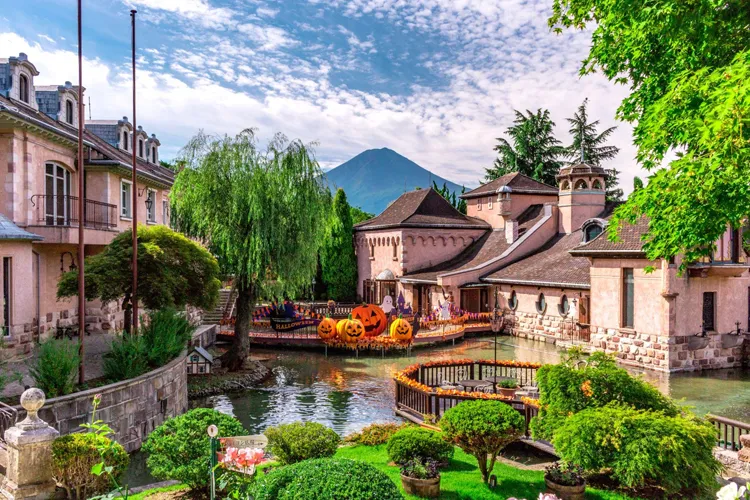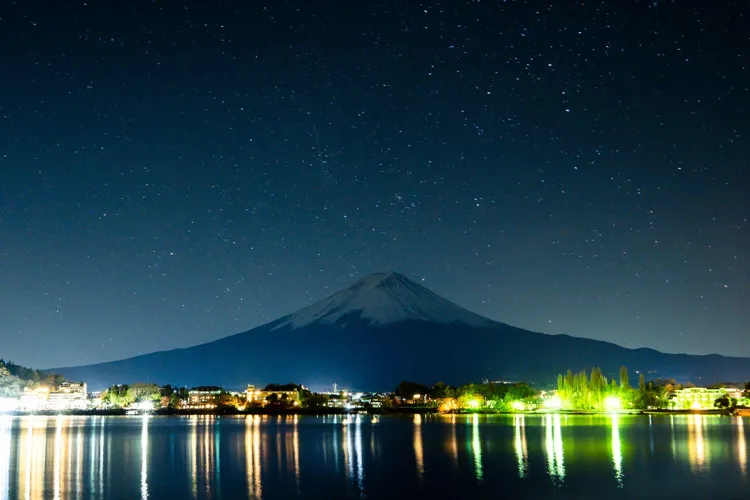- Home
- Japan Private Tours
- Mount Fuji & the Fuji Five Lakes Private Tours
Discover Mount Fuji & the Fuji Five Lakes: Iconic Views, Outdoor Adventures & Cultural Escapes
Mount Fuji and the surrounding Fuji Five Lakes region offer a perfect blend of breathtaking natural scenery, outdoor adventure, and cultural charm. Whether you're admiring the mountain’s snow-capped peak, soaking in a lakeside onsen, or exploring ancient shrines nestled in lush forests, this area promises unforgettable moments for every kind of traveler. In this guide, discover the best things to do, must-see spots, and tips for planning your ideal Mount Fuji itinerary.
Private Sightseeing Tours of Mt. Fuji and Fuji Five Lakes
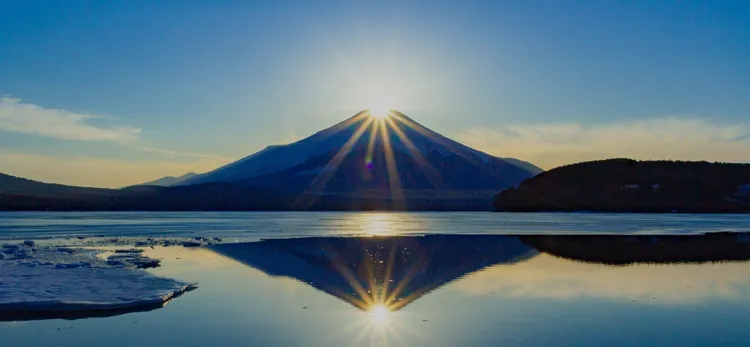
Mt.Fuji Private Tour
Mt.fuji & Lake Kawaguchi (Kawaguchiko)
Enjoy a full-day trip from Tokyo with an English-speaking driver. Visit the Fujisan World Heritage Center, 5th Station, have lunch, and explore Lake Kawaguchi (Kawaguchiko) — all with stunning Mt. Fuji views. Return to Tokyo with unforgettable memories.
Why Visit Mount Fuji & the Fuji Five Lakes?
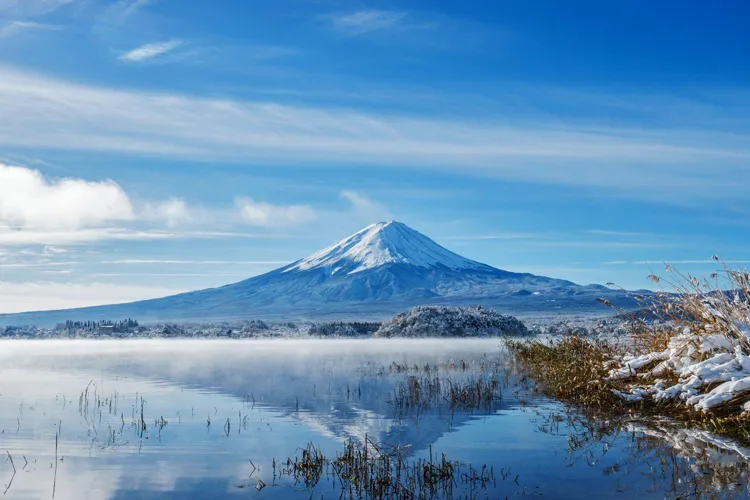
Welcome to the Mount Fuji & Fuji Five Lakes region, where Japan's most revered symbol majestically stands amidst a landscape of unparalleled natural beauty. Imagine waking up to the breathtaking sight of Fuji-san reflecting in serene lakes, exploring quaint traditional villages, and immersing yourself in vibrant seasonal scenery. This isn't just a destination; it's a journey into the heart of Japan's spiritual and natural heritage, offering iconic views and tranquil escapes.
- The Ultimate Mt. Fuji Experience: Witness unparalleled, iconic views of Japan's most sacred and beautiful mountain from various perspectives.
- Lakeside Serenity & Activities: Explore the five beautiful lakes that dot the base of the mountain, offering unique vantage points and recreational opportunities.
- Seasonal Spectacle: Experience a landscape that transforms dramatically with each season, from spring cherry blossoms to autumn foliage and winter snowscapes.
Quick Guide to Mount Fuji & Fuji Five Lakes
Ready to plan your unforgettable trip to the base of Mt. Fuji? Here’s what you need to know to get started.
Location & Access
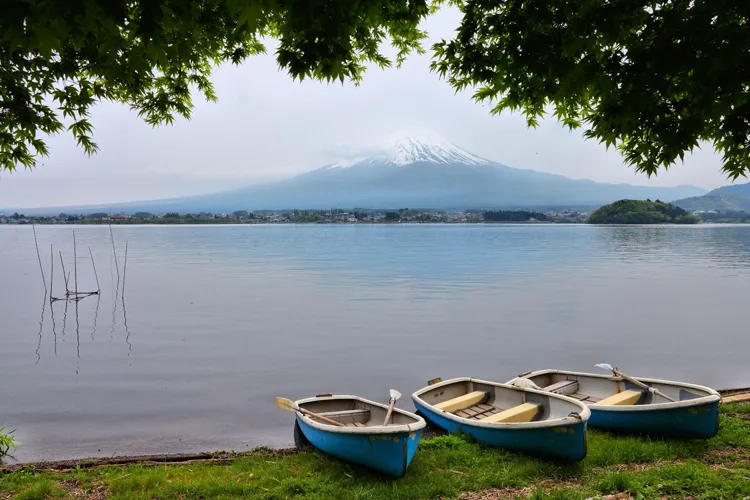
The Fuji Five Lakes (Fujigoko) region is located at the northern base of Mount Fuji, spanning Yamanashi and Shizuoka Prefectures. It's easily accessible from Tokyo and offers some of the best views of the iconic mountain.
From Tokyo:
- By Direct Highway Bus: The most convenient and often fastest option. Buses depart frequently from Shinjuku Expressway Bus Terminal (Busta Shinjuku) to Kawaguchiko Station (approx. 1.5-2 hours).
- By Train: Take the JR Chuo Line from Shinjuku Station to Otsuki Station (Limited Express Azusa/Kaiji, approx. 1 hour). From Otsuki, transfer to the Fujikyuko Line to Kawaguchiko Station (approx. 50 minutes-1 hour). (JR Pass covers JR Chuo Line to Otsuki)
Climate & Seasons
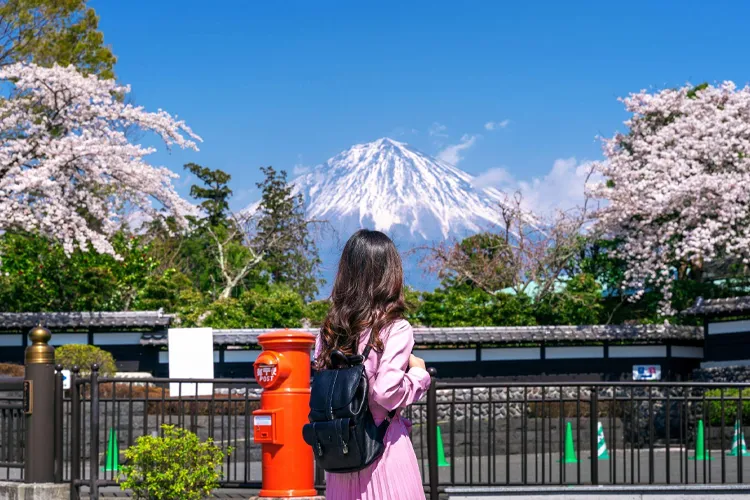
The Mount Fuji and Fuji Five Lakes region experiences four distinct and beautiful seasons, each offering a unique charm and spectacular views of Mt. Fuji.
- Spring (March - May): Mild temperatures (average 8-18°C/46-64°F) with cherry blossoms typically blooming in mid-April, often framed beautifully by snow-capped Mt. Fuji. Ideal for sightseeing. Light layers are recommended.
- Summer (June - August): Warm and comfortable (average 20-28°C/68-82°F) at the lakes, though higher elevations (like the Fuji climbing trails) are cooler. Perfect for outdoor activities and viewing vibrant flower fields. Light clothing is advised. Mt. Fuji climbing season is typically July-early September.
- Autumn (September - November): Crisp and refreshing (average 10-20°C/50-68°F), renowned for its spectacular autumn foliage, typically from late October to mid-November. This is a very popular season for photographers. Layers are essential.
- Winter (December - February): Cold (average -5 to 5°C/23-41°F) with clear, dry days offering the clearest and most iconic views of snow-capped Mt. Fuji. Occasional snowfall occurs. Warm winter clothing is essential.
When is the best time to visit? Autumn is highly recommended for its breathtaking fall colors. Winter offers consistently clear views of a fully snow-capped Mt. Fuji. Spring provides beautiful cherry blossom scenes, and summer is ideal for climbing Mt. Fuji.
Explore the Fuji Five Lakes & Surrounding Areas
The region is centered around the five lakes, each offering unique perspectives and attractions.
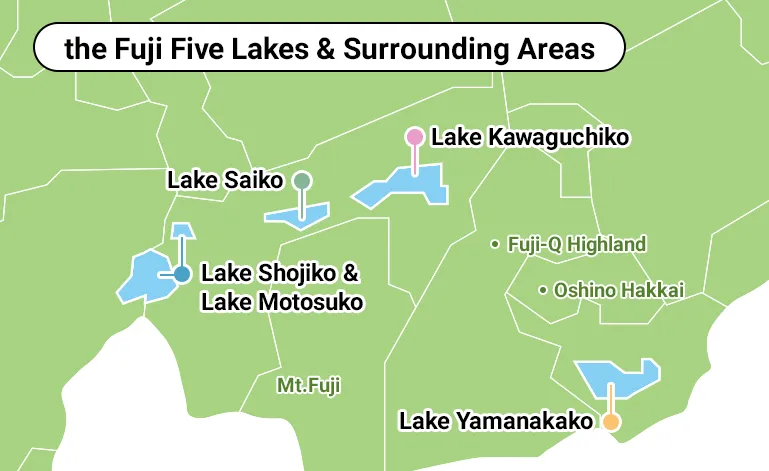
Lake Kawaguchi (Kawaguchiko)
- Highlights: The most popular and easily accessible of the Five Lakes, offering some of the best classic views of Mt. Fuji, especially with its reflection ("Sakasa Fuji"). Home to various museums, observation points, and recreational activities.
- Must-sees: Kawaguchiko Tenjozan Park (Ropeway & Panoramic Views), Chureito Pagoda (iconic photo spot with Fuji and pagoda), various boat cruises, and the Kawaguchiko Music Forest Museum.
- Charm: Vibrant, well-developed tourist hub with ample amenities and diverse viewpoints.
Lake Saiko
- Highlights: A more tranquil and less developed lake. Known for the Iyashi no Sato Nenba (Healing Village), a traditional Japanese village rebuilt with thatched-roof houses. Near Aokigahara Forest (Jukai).
- Charm: Serene and natural beauty, offering a peaceful escape and cultural insight.
Lake Yamanakako
- Highlights: The largest of the Five Lakes, known for its popularity among watersports enthusiasts and clearer views of Mt. Fuji from its eastern side. Offers seasonal flower fields.
- Charm: Lively for outdoor activities, with wide-open spaces and picturesque flower landscapes.
Lake Shojiko & Lake Motosuko
- Highlights: The smallest and most remote (Shojiko) and the deepest (Motosuko) of the lakes. Lake Motosuko is famous for being the lake depicted on the 1000 yen banknote for its classic Mt. Fuji view. Both offer more secluded natural experiences.
- Charm: Unspoiled nature, excellent for camping, fishing, and quieter enjoyment of Mt. Fuji.
Other Surrounding Attractions
- Oshino Hakkai: A traditional village with eight crystal-clear spring water ponds fed by Mt. Fuji's melted snow. Offers beautiful views of Fuji and quaint traditional scenery.
- Fuji-Q Highland: A thrilling amusement park known for its record-breaking roller coasters and direct views of Mt. Fuji.
- Mount Fuji Climbing: During the official climbing season (early July to early September), hikers can attempt to summit Japan's highest peak.
Find Your Perfect Mt. Fuji & Lakes Trip
The Mount Fuji and Fuji Five Lakes region offers diverse experiences to suit every interest.
For Nature Lovers & Outdoor Activities
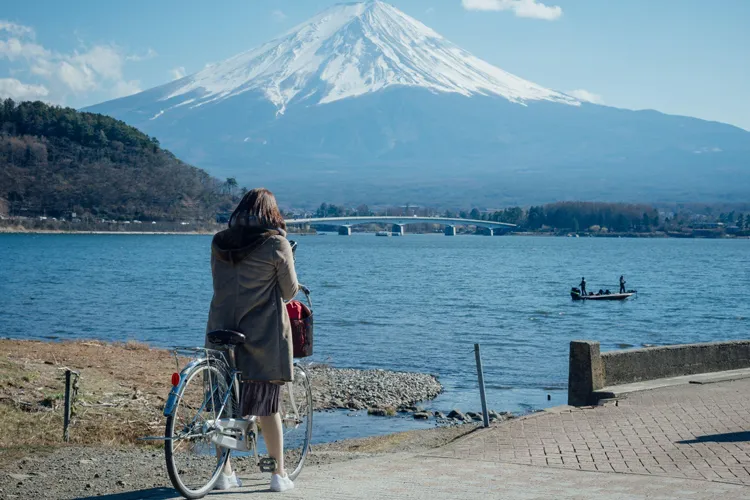
Immerse yourself in the stunning natural environment around Mt. Fuji:
- Lake Activities:Enjoy boat cruises, kayaking, paddleboarding, or fishing on the various lakes.
- Cycling: Rent a bicycle and explore the scenic lakeside paths, especially around Lake Kawaguchi (Kawaguchiko).
- Hiking & Walking: Explore trails around the lakes, through the Aokigahara Forest (with a guide), or, for the adventurous, climb Mt. Fuji during the summer season.
- Autumn Leaves Festival: Stroll along the "Momiji Corridor" (Maple Corridor) near Lake Kawaguchi (Kawaguchiko) for spectacular autumn colors.
For Culture & Traditional Charm
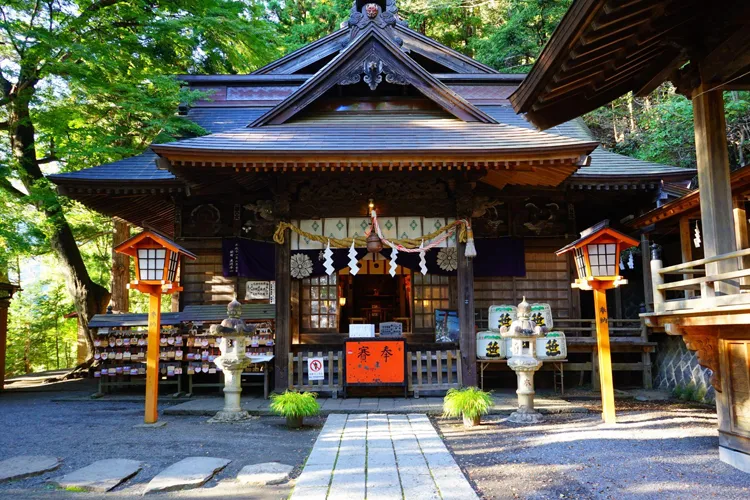
Discover the traditional side of life at the foot of the sacred mountain:
- Oshino Hakkai: Wander through this charming village with its crystal-clear ponds and traditional thatched-roof houses, offering a glimpse into old Japan.
- Iyashi no Sato Nenba (Lake Saiko): A beautifully restored traditional Japanese village with workshops where you can experience local crafts.
- Local Onsen: Relax in hot springs with views of Mt. Fuji, often found in Kawaguchiko or nearby.
- Fuji Sengen-jinja Shrines: Visit these ancient shrines, traditionally used by pilgrims before climbing Mt. Fuji.
For Thrills & Entertainment
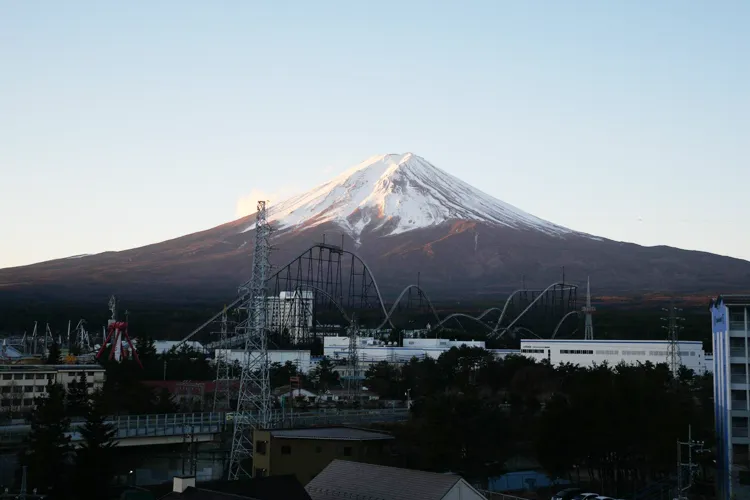
Get your adrenaline pumping with some unique entertainment:
- Fuji-Q Highland:Home to some of the world's fastest and tallest roller coasters, offering exhilarating rides with Mt. Fuji in the background. Perfect for thrill-seekers.
Top 5 theme parks in Japan-2025
For Photographers & Scenic Views
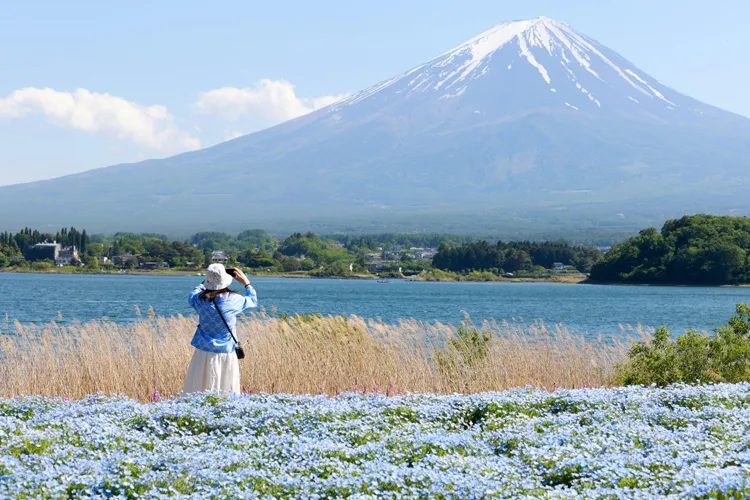
Capture the iconic beauty of Mt. Fuji from endless angles:
- Lake Kawaguchi (Kawaguchiko): The most popular spots for "Sakasa Fuji" (inverted Fuji reflection) and the classic view with the Chureito Pagoda.
- Lake Motosuko: The exact view depicted on the 1000 yen banknote.
- Oshino Hakkai: Picturesque traditional village settings with Mt. Fuji as a backdrop.
- Seasonal Framing: Capture Mt. Fuji with cherry blossoms in spring, vibrant summer flower fields (like lavender at Oishi Park), or brilliant autumn foliage.
- Fuji Shibazakura Festival (late April-May): A breathtaking field of pink moss phlox with Mt. Fuji in the background.
Mt. Fuji and Fuji Five Lakes FAQ
- Can I climb Mount Fuji year-round?
- No, the climbing season for Mt. Fuji is usually only from early July to early September. Outside this period, it is extremely dangerous due to snow and strong winds, so general climbers are not allowed to enter. Winter climbs are only for experienced climbers with proper equipment.
- Can I see Mount Fuji clearly year-round?
- No, there are many days when it is hard to see Mt. Fuji clearly due to weather and seasons. Especially in summer, clouds and fog often cover the mountain. From winter to spring (especially November to March), the air is clear, making it more likely to see the mountain well.
- Is Mount Fuji an active volcano? Is it safe to visit?
- Yes, Mt. Fuji is an active volcano, but its activity is currently calm, and it is safe to visit for tourism and climbing. However, emergency evacuation plans are in place in case of an eruption, so it is advisable to check them before visiting.
- Are tattoos allowed in Fuji area hot springs?
- Many hot springs in Japan restrict entry for people with tattoos. However, around the Fuji Five Lakes area, there are facilities with tattoo-friendly hot springs and private baths, which also cater to foreign tourists.
For example, Hottarakashi Onsen in Fujiyoshida City, Yamanashi Prefecture, allows guests with tattoos to bathe and is a popular hot spring known for its open-air baths with spectacular views. Located at the foot of Mt. Fuji is also recommended for day-trip tourists.
Policies vary by hot spring, so it is recommended to check the tattoo rules in advance. - Can I bring kids or elderly family members to the area?
- Yes, the Mt. Fuji and Fuji Five Lakes areas are popular family-friendly tourist destinations. There are activities that children can enjoy and many hot spring inns and scenic spots that are comfortable for elderly visitors, making it a safe area for all ages.


